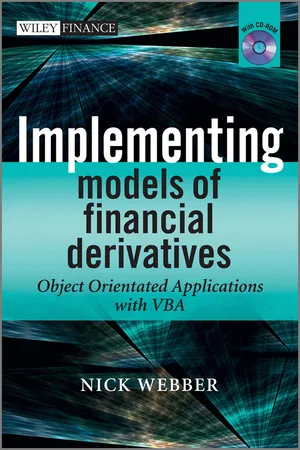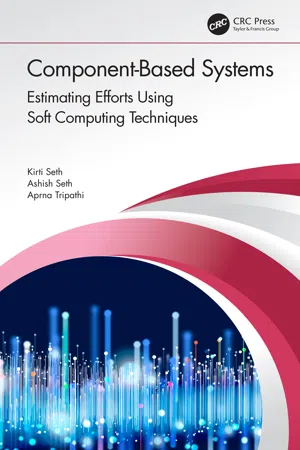Oops concepts
Oops concepts, short for Object-Oriented Programming (OOP) concepts, are fundamental principles used in software development. They include concepts such as inheritance, encapsulation, polymorphism, and abstraction, which enable the creation of modular, reusable, and maintainable code. OOP promotes the organization of code into objects, each with its own data and behavior, leading to more efficient and scalable software development.
5 Key excerpts on "Oops concepts"
- eBook - ePub
- Manoj Thulasidas(Author)
- 2012(Publication Date)
- Wiley(Publisher)
...The object interacts with the rest of the program through a set of published interfaces. The private data and the internal implementation methods are all hidden from the view of its users. The immediate benefits to the programmers, both to the users of the object as well as the developers of the class, is that as long as they honour the interface, they can make modifications both within and outside the class without affecting each other. This benefit translates to perfect modularity at the class level. It also puts enormous demands on the care needed to define the interfaces. Object-oriented languages also support inheritance, which makes the hierarchical ordering of classes a breeze. In our product example, we have the name and description members. However, these attributes also apply to the objects of other classes such as models and parameters. We can therefore define a base class (say ‘ thing ’) to handle these attributes along with the methods to set and display them. Other classes then inherit ‘ thing ’ without worrying about how to handle these common attributes. Inheritance greatly improves modularity. In our example, suppose we want to add another attribute, say a comment, to all objects derived from the base class thing. We can do that by modifying only the base class, without touching any of the derived classes. Another feature of the OOP paradigm is polymorphism, which lets the programmer treat all derived classes originating from a base class on an equal footing. In Figure 5.1, for instance, in an OOP implementation, the programmer could cast all the trades to its base trade class, put them in an array or a vector, loop over them and call the price method for each. The right price method, as implemented in the derived trade class, will be invoked, providing an elegant solution to our earlier problem, without resorting to ugly run-time checks...
- eBook - ePub
Implementing Models of Financial Derivatives
Object Oriented Applications with VBA
- Nick Webber(Author)
- 2011(Publication Date)
- Wiley(Publisher)
...See Appendix E for a fuller discussion of these issues. The programming style that uses objects idiomatically is called object-oriented programming (OOP). VBA is a not a fully OOP language: it lacks features that enable a proper concept of inheritance; it cannot make objects behave like primitive types; and it lacks the native ability to have meta-class date. There is limited scope to implement design patterns; for instance, although it is possible to implement the singleton pattern, the factory pattern, and registration and call-back, this can be done only with difficult work-arounds. Having said that, some of the patterns can be mimicked; see Part IV. Encapsulation is a concept that has come up several times. It is directly relevant to objects, where data, representing state, is held within an object. We have often and shall often refer to encapsulation in a broader sense to mean separating off data or functionality with the intention of making it harder for interfering busy-bodies to get their hands on it. Polymorphism is possible in VBA. This hugely important capability is discussed in Chapter 6. One feature that objects in VBA have, which is absent in C++, is the ability to raise events. For the moment we put events to one side; they are met, discussed and discarded (for our purposes) in Chapter 8. We distinguish between defining an object, declaring references to it, and instantiating it. The object definition is where the data, procedures and Property s within the object are defined. This happens in the object’s class module. An object declaration is the point at which the name of a reference to an object is introduced to the program. The instantiation is the point at which an object of some type is actually created...
- eBook - ePub
Component-Based Systems
Estimating Efforts Using Soft Computing Techniques
- Kirti Seth, Ashish Seth, Aprna Tripathi(Authors)
- 2020(Publication Date)
- CRC Press(Publisher)
...1 An Introduction to Component-Based Software Systems Improving business performance often requires improvement in the execution of product advancement, and this is the motivation that brings engineers and analysts closer to thinking about adopting the latest innovations and improvements. Previous systems evolved with the use of structured methodology, which was successful albeit only for straightforward applications. The Object Oriented (OO) approach came at that stage, which is based on encapsulation, inheritance, and polymorphism. Encapsulation combines the attributes and actions regulating the information in a single article. Inheritance engages a class, ascribes, and duties to be taken up by all subclasses and the items that they start from. Polymorphism allows different activities to have a similar name, reducing the estimation of the lines of code required to conduct a system. In the early 1990s, object-oriented programming became the main component of decisions made by some product manufacturers, a number of data frameworks, and experts in building. In spite of this, the core behavior of software engineers is still unchanged except for a few OO approach preferences: composing line-by-line code. In case of difficulties, it is not easy to implement object-bearing to complex applications. In addition, OO dialects reinforce class-level coverage of results, but not beyond that. Certain fundamental issues in the OO approach are integrity and privacy. 1.1 Component-Based Development This is an approach that recognizes the fact that many data-based systems include similar or even indistinguishable items that are generated over and over without any planning. Progress is increasingly costly from the start and can require a lot of effort to finish. Because of postponements in the improvement process, simple applications with severe time constraints can liberate the market...
- eBook - ePub
- Joy Ko, Kyle Steinfeld(Authors)
- 2018(Publication Date)
- Routledge(Publisher)
...1.02 OBJECTS, TYPES, AND EXPRESSIONS In this chapter we introduce a core metaphor that drives the interaction of code and data in computer programming: objects. Our discussion is led by an unpacking of the object model diagram used throughout this book, and its role in revealing the interplay between the computer code that we write and the structure of data stored in memory. Along the way, we encounter the concepts underpinning object-oriented programming (OOP), a way of thinking about computation that at once employs an easy-to-grasp visual metaphor while providing the powerful mechanisms of encapsulation and abstraction. An historical account may provide some guidance. Perhaps not coincidentally, one of the earliest examples of structuring a computer program in an object-oriented way is found in the ancestor of modern computer-aided design software. In 1963, as a part of his PhD dissertation at MIT, Ivan Sutherland developed a revolutionary program called Sketchpad, 8 which was capable of interpreting and storing graphical information drawn directly on a computer display with a “light pen”. While seeking to make computers accessible to artists and technical draftsmen alike, Sutherland’s work broke ground in many areas in computer graphics and human-computer interaction, most notably as one of the first demonstrations of the utility of a graphical user interface (GUI). Moreover, his approach to structuring data in Sketchpad has proven enormously influential. In his description of how his software structures the interactive display of a hexagonal grid, Sutherland explains that the “pattern is made of smaller patterns which are in turn made of smaller patterns which are composed of single hexagons...
- eBook - ePub
- Bill Sempf, Charles Sphar, Stephen R. Davis(Authors)
- 2010(Publication Date)
- For Dummies(Publisher)
...Chapter 6: Inheritance: Is That All I Get? In This Chapter Defining one class in terms of another, more fundamental class Differentiating between is a and has a Substituting one class object for another Constructing static or instance members Including constructors in an inheritance hierarchy Invoking the base class constructor specifically O bject-oriented programming is based on four principles: the ability to control access (encapsulation), inherit from other classes, respond appropriately (polymorphism), and refer from one object to another indirectly (interfaces). Inheritance is a common concept. I am a human, except when I first wake up. I inherit certain properties from the class Human, such as my ability to converse, more or less, and my dependence on air, food, and carbohydrate-based beverages with lots of caffeine. The class Human inherits its dependencies on air, water, and nourishment from the class Mammal, which inherits from the class Animal. The ability to pass down properties is a powerful one. You can use it to describe items in an economical way. For example, if my son asks, “What’s a duck?” I can say, “It’s a bird that quacks.” Despite what you may think, that answer conveys a considerable amount of information. My son knows what a bird is, and now he knows all those same characteristics about a duck plus the duck’s additional property of “quackness.” Object-oriented languages express this inheritance relationship by allowing one class to inherit properties from another...




